Staffordshire Bull Terrier
 Staffordshire Bull Terrier
Staffordshire Bull Terrier
Although Staffordshire Bull Terriers are independent and think for themselves, their indomitable courage, high intelligence, and tenacity are their greatest charms. Bold and fearless, they stand their ground without being troublesome. Stafford enthusiasts claim they are among the most trustworthy, affectionate, and gentle breeds known to mankind.
History of the Staffordshire Bull Terriers
 Bulldogs c 1817
Bulldogs c 1817
As their name implies, the Staffordshire Bull Terrier and their American counterpart, originated in the Staffordshire region of the English Midlands from old style Bulldogs like those pictured on the left. At first these were just popular companions of coal miners from the coal pits in the 'Black Country'. Apart from various old type Bulldogs with or without some Old English Terrier crosses, the only reliable evidence of structured development of either of these breeds before they were officially recognized is the taxidermy specimen of around 1890 that appears below.
 Staffordshire Bull Terrier c 1890
Staffordshire Bull Terrier c 1890
One century after blood sports were banned, police became fastidious about applying the law. So, dog shows were arranged and the first Breed Standard drawn up. This satisfied the police that Staffordshire Bull Terriers were 'show dogs', bred to compete.[4]
The Staffordshire Bull Terrier becomes a Pure Breed
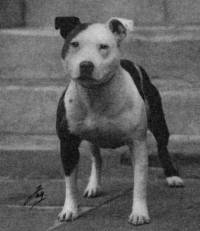 Stafford 'Gentleman Jim'
Stafford 'Gentleman Jim'
So the Staffordshire Bull Terrier we know today became known as a pure breed. But recognition by the Kennel Club UK was not until 1935. This was when a famous Stafford named 'Gentleman Jim' arguably founded the breed. His physical breed type was the basis for the first Breed Standard.
 Staffordshire Bull Terrier
Staffordshire Bull Terrier
But it was not only Gentleman Jim's good looks that made him famous. As his name implies, he and his offspring were tractable, intelligent and easily trained. At a time when some Staffords were boisterous and rough while others were equally docile and gentle[4], the popularity of today's Stafford is testament to it's breeders for the continuous selection of dogs like 'Gentleman Jim' with his excellent type and temperament.
History of Staffordshire Bull Terriers in Australia
 Liz and Jezabel of Broomsquires
Liz and Jezabel of Broomsquires
The first Staffords to be registered in Australia were 'Showna Bobbysox' and 'Paddy Again' which were both registered in Victoria in 1948[5]. But Staffords became established in Australia in 1951 when several arrived independently from the UK founding the breed in each of the Eastern States as well as South Australia.
 John Sheward with Liz and Jez
John Sheward with Liz and Jez
In 1951 John Sheward settled in Victoria after emigrating from England with his wife and two teenage daughters. While the girls travelled free, Mr Sheward had to pay for his wife and his 3 Stafford bitches! One of these was Liz of Broomesquires which had been mated to Eng Ch Godfreys Pride, a grandson of 'Gentleman Jim' before leaving England. One of Liz's pups was Broomsquires Chip[5].
 Jim Craig with Ch Fiona Beauty
Jim Craig with Ch Fiona Beauty
In 1958, Mr Jim Craig brought Ch Fiona Beauty (imp UK) also into Victoria. She had already been awarded Best of Breed at Crufts in England. Mated to Broomsquires Chip, she produced Cinderbank Chip whose son in turn, Cinderbank Major was the first Stafford Champion in NSW. So, the Broomsquires bitches certainly influenced Victoria's early Staffords!
In Queensland in 1951, Bill Stevens arrived with a pair of Staffords 'Tinker's China' and 'Bell's Hope' whose puppies, bred under the Westaff prefix, was the first Stafford prefix to be registered in Australia. Bill played a big part in establishing the breed in Qld[1]. Also in Queensland around 1956 Dr Chris Lamb imported 'Brindle Babs of Bandits', sired by the legendary 'Ch Fearless Fred of Bandits' which produced the first Stafford to gain an all-breeds in-show award in Australia.
In South Australia 1951, Mr Ted Forster migrated here with a dog 'Zarian Voyager' who was mated to a daughter of the early Victorian import, Showna Bobbysox'[3].
Influence of New Zealand's Staffords
 Aust & NZ Ch Mowcop Maestro
Aust & NZ Ch Mowcop Maestro
As transporting dogs between Australia and our neighbour New Zealand (NZ) is relatively uncomplicated, the contribution of Marion Forester was significant in influencing the development of Australian Staffords. Marion had already made a name for herself in England prior to emigrating to NZ in 1949. She shared many of her stud dogs with Australians like the one on the right[2].
Additionally, from her Loggerheads kennel in New Zealand, she bred and sent to Australia several Staffords that were excellent for their time. These had a marked influence on the early development of the Staffordshire Bull Terrier in Australia.
Comparison between the Staffordshire Bull and American Staffordshire Terrier
 Amercan Staffordshire Terrier
Amercan Staffordshire Terrier
Originating from the same source, almost a century of development has separated these two different breeds which, at first might appear similar. But a closer examination reveals the difference in the general build of these two breeds. Although the Staffordshire Bull Terrier should be obviously smaller, the American Staffordshire has a far more graceful build with his longer neck and slightly sloping topline. Also the allowable of the two breeds have remained remarkably similar.
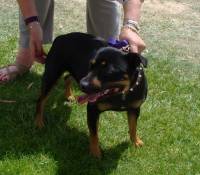 Oops-Undesirable Colour!
Oops-Undesirable Colour!
However, liver and black and tan are not allowed. This is because those who first developed the breed believed these colours indicated cross-breeding. However, it is amazing how these colours can suddenly crop up in the best of litters as evidenced by the attached picture of quite a nicely conformed modern Staffordshire Bull Terrier with the typical black and tan marking pattern.
| Staffordshire Bull Terrier | American Staffordshire Terrier | |
|---|---|---|
| General Appearance | Muscular and agile with great strength for its size | Muscular and agile with great strength for its size but graceful without being long legged or racy |
| Size | Desirable height at withers 36-41 cms (14 to 16 ins), these heights being related to the weights. Weight: dogs: 13-17 kgs (28-38 lbs); bitches 11-15.4 kgs. | Bearing in mind the height and weight should be in proportion, the height for dogs is around 46 - 48 cms (18 - 19 inches) at the shoulder with bitches 43 - 46 cm (17 - 18 inches) |
| Colour | Any of the following colours either whole or mixed with white: red, fawn, white, black or blue or of the brindle colours. Black and tan or liver highly undesirable. | Any solid, patched or parti-colour is permissible. However all white or more than 80% white or black and tan or liver not to be encouraged. |
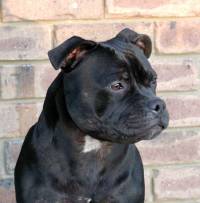 Staffordshire Bull Terrier Staffordshire Bull Terrier |
 Amercan Staffordshire Terrier Amercan Staffordshire Terrier |
|
| Head | Short through and deep through with broad skull, very pronounced cheek muscles and distinct stop. The nose is black but the foreface should be short. | Medium length and deep through with broad skull, very pronounced cheek muscles and distinct stop. The nose is black but the foreface should be of medium length and fall away under the eyes. |
| Eyes | Dark and round, of medium size and set to look straight ahead. | Dark and round, set low in skull and far apart |
| Ears | Rose-shaped or semi-erect but not large | Small, rose-shaped or semi-erect |
| Mouth | Lips tight, perfect scissors bite | Lips tight, perfect scissors bite |
| Neck | Rather short, muscular with no dewlap | Medium length, heavy and slightly arched with no dewlap |
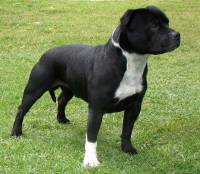 Staffordshire Bull Terrier Staffordshire Bull Terrier |
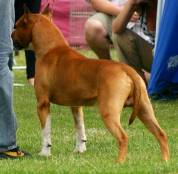 Amercan Staffordshire Terrier Amercan Staffordshire Terrier |
|
| Forequarters | Forelegs straight, set wide apart with upright pasterns, but front feet may turn out a little (for balance). | Forelegs straight, large with round bone, with upright pasterns. The forelegs are set wide apart (to allow chest development). |
| Topline | Level | Sloping slightly from withers to rump with a gentle short slope at rump to base of tail. |
| Body | Balanced, well sprung ribs with chest deep and wide | Fairly short, well sprung ribs with chest deep and broad |
| Hindquarters | Well muscled with a good turn of stifle and short hocks that neither turn in nor out | Well muscled with a good turn of stifle and short hocks that neither turn in nor out |
| Feet | Medium sized with well arched toes | Medium sized, well padded feet with black nails in solid coloured dogs |
| Tail | Medium length, set low and tapering to a point and carried low. The tail's shape and carriage may be likened to an old fashioned pump handle. | Short compared with the size of the dog, set low and tapering to a point. The tail should be fairly straight and never curled or carried over the back. |
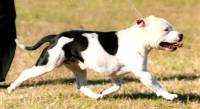 Staffordshire Bull Terrier Staffordshire Bull Terrier |
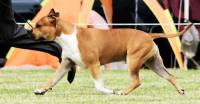 Amercan Staffordshire Terrier Amercan Staffordshire Terrier |
|
| Gait | Free, with discernible power derived from its hindquarters. With economy of effort, the legs should be parallel when viewed from the front or rear. | Springy without roll or pace. |
| Coat | Smooth, short and close. | Short, close and glossy feels stiff to touch. |
References and Further Reading
BREAKING NEWS.
We have now published a unique Terrier book 'Terriers Unveiled' Available at our sister site: https://rangeairevision.com/terriers-unveiled/
[1] Noel Newham, "The Staffordshire Bull Terrier in Australia" in the "The British Terrier Club of NSW Diamond Jubilee Handbook 1907 - 1967" published by Hi-Line Press Page 129
[2] Marion Forester ''The Stafford in New Zealand'' in the New Zealand Kennel Gazette published by the New Zealand Kennel Club Ltd Porira NZ Vol 23 No 2 March 1983 Pages 68 - 76.
[3] Jeanette Bruce, "The Staffordshire in Australia" National Dog Newspaper Editor Frances Sefton, Windsor NSW June 1975 Pages 8 - 9.
[4] Brian Vesey-Fitzgerald, 'The Book of the Dog' Published by Nicholson & Watson, London 1948 Part 11 'Staffordshire Bull Terrier' by Phil Drabble, Page 667
[5] Pedigrees sourced from the VCA Library
[6] Kim Dennis-Bryan and Juliet Clutton-Brock - 'Dogs of the Last Hundred Years at the British Museum' Published by British Museum (Natural History), London (1988) ISBN 0-565-01053-0 Old fashioned Bull Terrier which became the Staffordshire Bull Terrier Page 81.
See also our DVD 'Terriers Then & Now' contains more about the Staffordshire Bull Terrier and the American Staffordshire Terrier